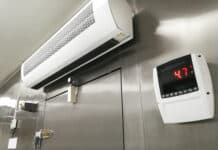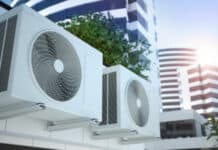By Roger Harle
There are some standard best practices for specifying and using portable cooling units to meet various requirements and achieve the desired results. Circumstances that require a portable cooling solution can vary widely. Some typical applications include:
- Emergency response to address an existing HVAC problem, particularly in schools or mission-critical buildings, like hospitals and data centers
- Cooling temporary structures and tents used in events
- Scheduled maintenance outages for HVAC systems
- Supplemental cooling for server rooms, data centers, or manufacturing facilities that have high internal heat loads
- Process cooling applications found in industrial and manufacturing facilities that require specific temperatures to protect product inventories and production equipment
- Supplemental cooling for labs or hospital equipment rooms housing MRI or similar machines
- Safety and heat mitigation during construction, warehousing, or in manufacturing industries
For those less familiar with temporary portable cooling solutions, there are short- and long-term rental options. A rental partner can help you determine the appropriate solutions for your specific application and provide instructions on proper equipment usage.
Temporary portable cooling solutions work well for applications in harsh environments since the rental provider manages all maintenance and repairs, which lifts the burden from the user. Equipment rental is also considered an operating expense, rather than a capital expenditure, which is appealing to many.
PORTABLE COOLING OPTIONS
There are three main categories of portable cooling units: air-cooled air conditioners, water-cooled air conditioners, and evaporative cooling fans. The specific requirements of the job will determine which type of cooling solution will work best for the application.

While air-cooled air conditioners are well suited for most applications, there are instances where a water-cooled air conditioner is needed. Air-cooled units are available in sizes ranging from one-ton commercial indoor units to large 12- and 25-ton air conditioners for indoor and outdoor use. The air-cooled air conditioners exhaust the heat outside of the space into a designated area, such as a drop ceiling or through a window. Water-cooled options are available in 1- to 5-ton units. The water-cooled units require a source of cold water and a drain. The water circulates through the unit and removes the heat from the space.
Evaporative cooling fans may be a good solution for large warehouses, tents, sporting events, or outdoor cooling stations, as well as manufacturing facilities and agricultural applications. These units operate on 110V power and can provide cooling in hot, dry applications. They are used to mitigate high temperatures and the risk of heat stress.
SPECIFYING THE RIGHT SOLUTION
Sizing a portable cooling solution considers a number of factors specific to the application. To achieve the desired results, the heat load should be calculated based on the criteria of the user. Accordingly, the solution provided may include air conditioners or evaporative cooling units. The goal of either is to remove the heat from the space and distribute cool air throughout the space.
Failure to accurately calculate the heat load for the application results in improperly sizing the cooling solution. However, using some key best practices can help prevent issues.
1. Determine the type of cooling application. There are different types of cooling applications: comfort cooling for people in the space; spot cooling for specific areas or zones; cooling for heat remediation; and process cooling. Each type of cooling application requires a specific set of calculations based on desired temperatures inside the space.
2. Figure the square footage of the space. Air conditioners and evaporative cooling units are available with different volumes of cooling capacity, rated in tons (12,000 BTU). To determine the appropriate size unit, it is necessary to know the square footage of the area to be cooled. For comfort cooling applications, a well-insulated and sealed space requires one ton of cooling for every 400 square feet. Divide the square footage by 400 feet to calculate how many tons are needed. For example, a 1,200-square-foot room would call for three tons of cooling.
3. Assess additional heat loads. After determining the required tonnage of cooling, assess if there are additional heat loads. These could include heat generated from electrical equipment, such as computers or electric motors; solar heat loads on exterior glass walls and windows; excessive outside air infiltrating into the space through open doors; and the number of people occupying the space. Consider this example to decide the amount of supplement cooling to add: Each ton of cooling is equivalent to 12,000 BTUs. Depending on the level of activity of the people, each person can produce 400 to 900 BTUs of heat. If 15 people are exercising in a room, they collectively produce up to 13,500 BTUs of heat. Divide that number by 12,000 to determine the additional tonnage to add to the original estimate—in this case, approximately one more ton.
4. Consider the height and type of ceiling. In a standard space with drop ceilings, an air-cooled air conditioner is a common solution. It’s necessary, however, to determine if the drop ceiling is used as a return-air plenum for the HVAC system. If that’s the case, then any return air grills will need to be covered prior to installation. The central air conditioning system will also have to be shut off when ducting to avoid circulating heat back down into the space. If the drop ceiling has ducted returns, the portable air conditioner can exhaust the hot condenser air directly into the voided space above the drop ceiling.
If ceilings are sheetrock or exposed to deck, water-cooled air conditioners are the best option.
Whether a space has a drop ceiling or not, the specified solution needs to provide enough tonnage to cool effectively. Higher ceilings will require increased tonnage.
5. Know the available power. Portable cooling units require various power depending on the size of the unit. For example, the 1- and 1.5-ton units require 110V power and can be plugged into wall outlets. Larger 3- and 5-ton air-conditioner units typically require 230V / 1 phase power and 12- and 25-ton units typically require 480V / 3 phase power. Depending on the type of power available, the cooling could be provided by one large unit, or several small or medium ones. In many applications, supplemental power is required when large generators are used.
OTHER CONSIDERATIONS
In addition to providing the engineered solution and properly sizing the job, it is important that the installation adheres to safety standards. Personal protective equipment (PPE), including steel-toe boots, hard hats, safety glasses, and gloves, is required. When employing a rental partner to implement portable cooling, they can provide a turnkey solution that includes delivery, setup, installation, and start-up of the equipment. The user can rely on a complete solution for all their cooling needs.
 Harle is the National Sales Manager, Commercial for Sunbelt Rentals Climate Control Services. He and his team members work to provide industry leading solutions specializing in temporary cooling, dehumidification, heating, and indoor air quality equipment. Harle has been with Sunbelt Rentals since 2017 and can be reached at Roger.Harle@sunbeltrentals.com.
Harle is the National Sales Manager, Commercial for Sunbelt Rentals Climate Control Services. He and his team members work to provide industry leading solutions specializing in temporary cooling, dehumidification, heating, and indoor air quality equipment. Harle has been with Sunbelt Rentals since 2017 and can be reached at Roger.Harle@sunbeltrentals.com.



















![[VIDEO] Collect Asset Data at the Speed of Walking a Building](https://facilityexecutive.com/wp-content/uploads/2024/02/maxresdefault-324x160.jpg)